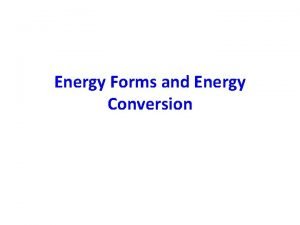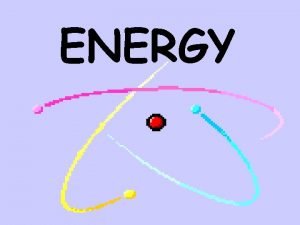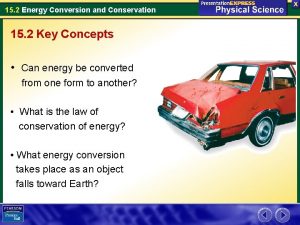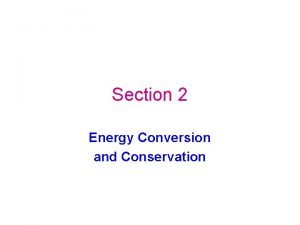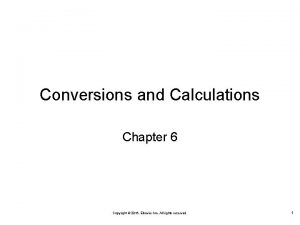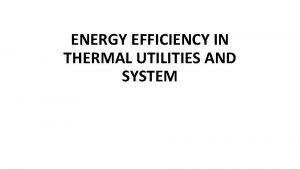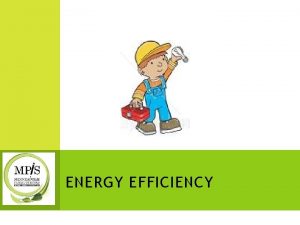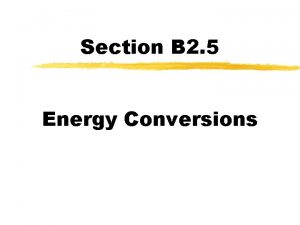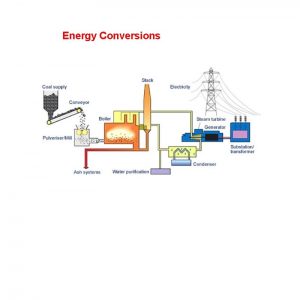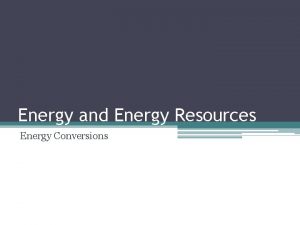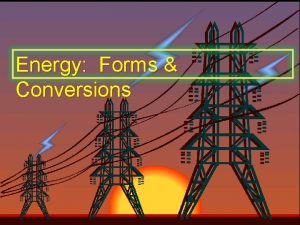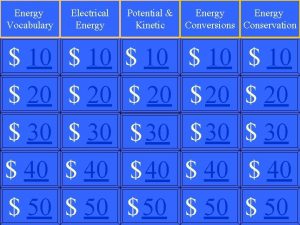Chapter 6 Energy Conversions and Efficiency Simple Systems




















- Slides: 20

Chapter 6 Energy Conversions and Efficiency

Simple Systems: Pendulums • Pendulums continuously convert between Ep and Ek • When we release a pendulum, Ep is converted to Ek until it reaches the lowest point (2). • At this point the pendulum is at Vmax and all of its energy is Ek • At the highest points, the pendulum stops momentarily before changing direction (1 and 3) Here all of its energy is Ep

Pendulum simulation If we ignore energy loss to friction, total energy is equal anywhere along the pendulum's path EP= mg∆h Ek = ½ mv 2

Example • A pendulum with a mass of 1. 0 kg is raised 0. 5 m above its resting point. Calculate the maximum speed of the pendulum.

• At the top, all energy is Ep Ep = mg∆h = (1. 0 Kg)(9. 81 m/s 2)(0. 5 m) = 4. 905 J • Max speed is at the bottom where all energy is Ek and we now know how much energy is in the system. • Ek = ½ mv 2 4. 905 J = ½(1. 0 Kg)(v)2 V= 3. 312 m/s

• A 35 kg girl on a trampoline gains 500 J of gravitational potential energy at the top of her bounce. Find the elastic potential energy of the trampoline

• A 35 kg girl on a trampoline gains 500 J of gravitational potential energy at the top of her bounce. Find the elastic potential energy of the trampoline • 500 J

• A 35 kg girl on a trampoline gains 500 J of gravitational potential energy at the top of her bounce. How high does she bounce?

• A 35 kg girl on a trampoline gains 500 J of gravitational potential energy at the top of her bounce. How high does she bounce? Ep = mgh h = Ep = 500 J = 1. 5 m m (35 kg)(9. 81 m/s 2)

• Video Mon. D Physics of Fun

6. 1 Efficiency of Energy Conversions Calculating Efficiency • Efficiency is a ratio and is expressed as a percent. • Output and input energies must use the same units. Efficiency = useful output energy × 100% total input energy or Efficiency = Eout × 100% Ein

• A cyclist uses 52 k. J of energy in a 100 km race. If he averages 50 km/h and the total mass of bike and rider is 80 kg, what is his % efficiency?

• A cyclist uses 52 k. J of energy in a 100 km race. If he averages 50 km/h and the total mass of bike and rider is 80 kg, what is his % efficiency? • • Ein = 52 k. J = 52 000 J Eout = Ek Vave = 50 km/h = 13. 88889 m/s m = 80 kg

• A cyclist uses 52 k. J of energy in a 100 km race. If he averages 50 km/h and the total mass of bike and rider is 80 kg, what is his % efficiency? • Ein = 52 k. J = 52 000 J • Eout = Ek • Vave = 50 km/h = 13. 88889 m/s • m = 80 kg Ek = ½ mv 2

• A cyclist uses 52 k. J of energy in a 100 km race. If he averages 50 km/h and the total mass of bike and rider is 80 kg, what is his % efficiency? • Ein = 52 k. J = 52 000 J • Eout = Ek • Vave = 50 km/h = 13. 88889 m/s • m = 80 kg Ek = ½ mv 2 = ½ (80 kg)(13. 88889 m/s)2 = 7716 J

• A cyclist uses 52 k. J of energy in a 100 km race. If he averages 50 km/h and the total mass of bike and rider is 80 kg, what is his % efficiency? • Ein = 52 k. J = 52 000 J • Eout = Ek • Vave = 50 km/h = 13. 88889 m/s • m = 80 kg Ek = ½ mv 2 = ½ (80 kg)(13. 888889 m/s)2 = 7716 J Efficiency = Eout Ein

• A cyclist uses 52 k. J of energy in a 100 km race. If he averages 50 km/h and the total mass of bike and rider is 80 kg, what is his % efficiency? • Ein = 52 k. J = 52 000 J • Eout = Ek • Vave = 50 km/h = 13. 88889 m/s • m = 80 kg Ek = ½ mv 2 = ½ (80 kg)(13. 888889 m/s)2 = 7716 J Efficiency = Eout = 7716 J x 100 % = 15% Ein 52 000 J

• Look at Model Problem 1 page 225 – 226 • Do Practice Problems page 227 # 1 -9

• Do Workbook BLM 6 -2 Calculating Efficiency • Do Check Your Understanding p. 231 #1 - 5, 7

6. 2 Energy Efficiency and the Environment • • The average car is only 20% efficient. Incandescent light bulbs are only 5% efficient. Compact fluorescents are 20% efficient For every litre of gasoline burned 2. 4 kg of CO 2 is released into the atmosphere. • Read P. 232 – 241 and do P. 242 # 1 -9
 Energy forms and energy conversions
Energy forms and energy conversions Renewable energy and energy efficiency partnership
Renewable energy and energy efficiency partnership Productive inefficiency and allocative inefficiency
Productive inefficiency and allocative inefficiency Allocative efficiency vs productive efficiency
Allocative efficiency vs productive efficiency Productive inefficiency and allocative inefficiency
Productive inefficiency and allocative inefficiency Energy conversions examples
Energy conversions examples Energy conversions examples
Energy conversions examples How gulls use energy conversions
How gulls use energy conversions How gulls use energy conversions
How gulls use energy conversions Car energy transformation
Car energy transformation Energy conversion of blender
Energy conversion of blender Blender energy transformation
Blender energy transformation Conversions and calculations chapter 6
Conversions and calculations chapter 6 Energy energy transfer and general energy analysis
Energy energy transfer and general energy analysis Energy energy transfer and general energy analysis
Energy energy transfer and general energy analysis Payment systems efficiency
Payment systems efficiency Saudi energy efficiency program
Saudi energy efficiency program Energy efficiency
Energy efficiency Energy efficiency in thermal utilities
Energy efficiency in thermal utilities Taiwan energy efficiency label
Taiwan energy efficiency label Energy efficiency management office
Energy efficiency management office
